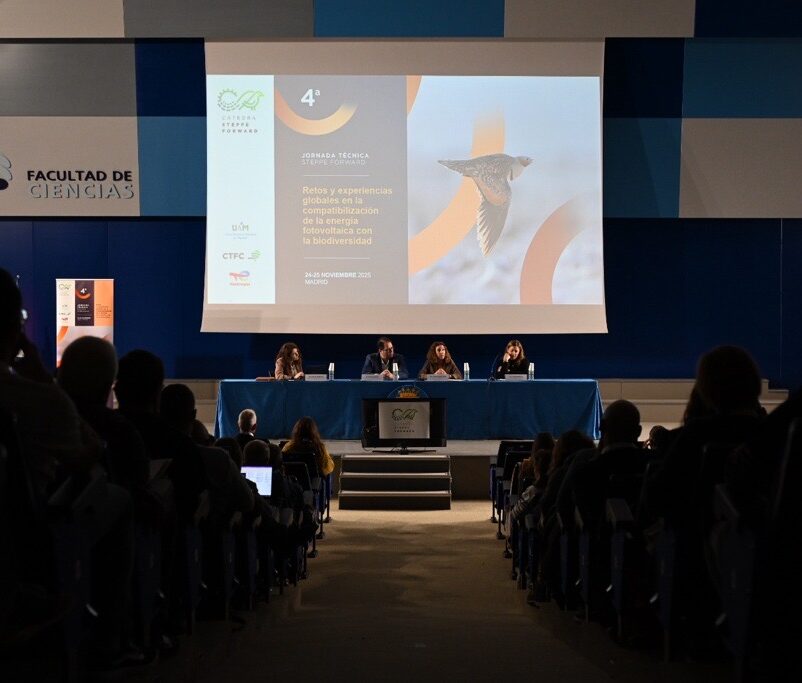The Steppe Forward Chair held its 4th Technical Conference on November 24 and 25, focused on “Global challenges and experiences in reconciling photovoltaic energy with biodiversity.”
The event, which brought together nearly 300 participants, convened national and international experts, academic professionals, public administrations, and companies linked to the energy sector at the Aula Magna of the Biology Building at the Faculty of Sciences of the Autonomous University of Madrid.
The program was organized into three thematic areas: current methodologies for environmental impact assessment, management measures within solar facilities, and compensatory actions outside operational perimeters. Throughout the two-day conference, plenary sessions, presentations, and discussion spaces were held, allowing attendees to learn about recent research and real-world examples in diverse contexts on how to reconcile photovoltaic energy and biodiversity conservation.
The institutional opening was led by Irene Aguiló Vidal, Director General of Biodiversity and Forest Management of the Community of Madrid, along with representatives of the entities promoting the Chair.
In her remarks, Irene Aguiló Vidal emphasized: “We have collaborated with the founders of the Chair from the beginning, both in identifying the main impacts of photovoltaic deployment in Madrid and in designing our agri-environmental program, through which we organize all the compensatory actions linked to this development. That is why I want to thank the companies developing projects in Madrid and the land stewardship organizations for their efforts in starting to work even before laying the first stone. This anticipation allows us to have an advanced understanding of the territory and ensures that, when developments begin, actions can be implemented immediately and yield results relatively soon.”
Meanwhile, Borja Guzmán, Director of Asset Management and Operations at TotalEnergies Renewables Spain, stated that “at TotalEnergies, developing our projects responsibly is a true hallmark, and an initiative like the Steppe Forward Chair is essential to verify that we are on the right path and that the measures we implement are the best available. The key to its success lies in its multidisciplinary approach, which makes it possible to generate scientific knowledge, protocols, and global action models for the academic, corporate, and public management spheres.”
Rocío Schettini del Moral, Director of the Autonomous University of Madrid Foundation (FUAM), said in her welcome to attendees that “the 4th Steppe Forward Conference represents a privileged space to advance dialogue on an energy transition compatible with the protection of agro-steppe biodiversity. At the Autonomous University of Madrid Foundation, we are proud to support this initiative, convinced that scientific knowledge and collaboration between entities are key factors in achieving the Chair’s objective: reconciling renewable energy development with the conservation of our ecosystems.”
Roser Maneja, Research Director at the Forest Science and Technology Centre of Catalonia (CTFC), highlighted “the great strategic value of this conference as a meeting point for public administrations, the energy sector, environmental consulting, and the scientific community. The Steppe Forward Chair is currently one of CTFC’s strategic projects, not only because of its relevance and scientific contributions, but also for its public-private collaboration model and for working through an inter- and multidisciplinary perspective. The Char is a global pioneer in its field and aims to contribute scientific knowledge to improve decision-making processes in energy transition based on solid sustainability criteria. Without a doubt, one of the greatest contributions science can make in these complex times of climate emergency.”
The three sponsoring organizations highlighted the fundamental role that the Steppe Forward Chair’s findings have played so far and reaffirmed their commitment during the renewal ceremony held before the official opening of the conference.
The presence of international specialists brought a comparative perspective on the relationship between solar energy and the conservation of sensitive fauna and habitats. Stefania Charisiadou, Nature Conservation Policy Officer at the European Commission, indicated that “accelerating the deployment of renewable energies is vital, but we must do so in a way that respects, protects, and—when possible—enhances biodiversity. If we use our existing legislative frameworks for renewable energy and nature wisely and strategically, we can generate real synergies.”
Meanwhile, Dr. Todd Katzner, researcher at the United States Geological Survey (USGS), explained that “solar energy is expanding rapidly worldwide. This provides a unique opportunity for research that can help understand its potential environmental impacts and mitigation options.”
Finally, Bertrand Schatz, researcher at the French National Centre for Scientific Research (CNRS), emphasized that “pollinators are experiencing a massive decline in Europe, primarily due to pesticides and habitat degradation. Photovoltaic plants can pose an additional threat, although there are solutions to avoid, reduce, and compensate for their impacts.”
The fourth edition of the Technical Conference concluded with a shared takeaway: the need to continue creating spaces where science, public administration, and the energy sector can exchange data and experiences that facilitate the development of photovoltaic projects with greater attention to biodiversity.
Steppe Forward, a pioneering chair
The Steppe Forward Chair began in 2022, driven by the Autonomous University of Madrid (UAM), the Forest Science and Technology Centre of Catalonia (CTFC), and TotalEnergies, a multi-energy company. As part of this pioneering project, the three entities work together to promote an energy transition that combines photovoltaic production with the conservation of steppe biodiversity. It is a pioneering chair in Europe, as it is the only one focused on reducing the environmental impact of photovoltaic plants through studies, scientific research, and fieldwork, among other activities.
Last modified: 27 November 2025










